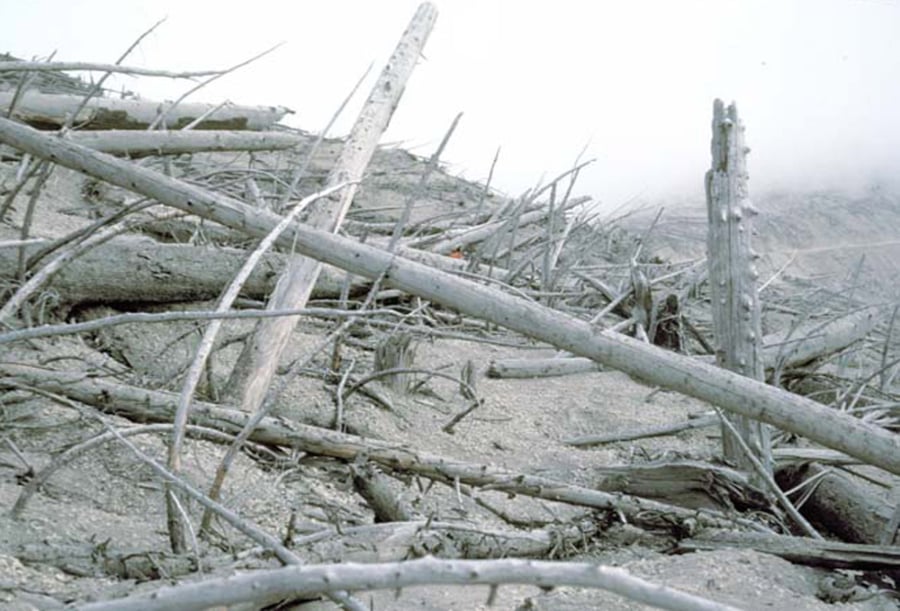RIDGEFIELD — One image is forever stamped on Allene Wodaege’s memory after journeying deep into Mount St. Helens’ blast zone more than three years following the volcano’s 1980 eruption.
Ash. Nothing but gray, lifeless ash covering almost everything as far as the eye could see.
“It was very quiet,” Wodaege said. “That ash seemed to just hush everything. It was that gray there. The ash just deadens everything.”
In fall 1983, Wodaege, program coordinator at Cispus Learning Center near Randle, and Ron Ward, a fifth-grade teacher in the Ridgefield School District, had an unusual opportunity.
National Geographic World, renamed National Geographic Kids in 2002, wanted to send a reporter and photographer into the area desolated by the volcano’s power for a story about the mountain’s slow recovery.
Wodaege and Ward jumped at the chance to take a small group of fifth-graders and adults there for the story.
Wodaege, 84, of Ridgefield and Ward, 76, of Vancouver were reunited last week to reminiscence about a brief trip more than 35 years ago. Their memories have been dulled by time and advancing age, but their zeal for life remains strong.
“Good God, Ron,” Wodaege exclaimed shortly after Ward walked into her Ridgefield home.
“Yeah, I’m still alive,” Ward replied in a hoarse whisper.
“So am I,” she answered.
Not much was left alive near Mount St. Helens 39 years ago today.
On May 18, 1980, after two months of building magma, frequent earthquakes and small eruptions, Mount St. Helens cut loose with previously unimaginable ferocity.
At 8:32 a.m., a magnitude 5.1 earthquake triggered a massive landslide, the biggest in recorded history, on the mountain’s north flank that ripped Mount St. Helens wide open. In a matter of seconds, the mountain’s power was uncorked and a lateral blast shot out, sending a wave of heat and destruction that spared little from the volcano’s fury.
But not at Meta Lake, some seven miles northeast of the volcano.
When Mount St. Helens erupted, Meta Lake was covered by 8 feet of snow, which shielded plants, fish, amphibians and small mammals beneath a frozen barrier. In future years, these and other sanctuaries of life would provide the plants and animals to help fuel the area’s gradual rebirth.
During his first trip into the blast zone, Ward remembers Meta Lake stood out “like a gem in the desert,” a stark contrast to a barren moonscape where everything else was gray, still and dead.
Ward remembers the force of the eruption had bent a tree over like an inverted “U.”
“I was surprised to see the grass,” he said about the vegetation along Meta Lake’s shores. “I was surprised to see anything green there.”
This was the first of a dozen trips Ward would take guiding fifth-graders into the blast zone.
For future trips, Ward developed a detailed curriculum. Students would record their observations as they moved up the mountain’s foothills to Meta Lake, Bear Prairie and Windy Ridge. Ward told students to list plants that were “survivors” of the blast, along with “pioneers” that had arrived or returned after the eruption.
On his first trip in 1983, Ward took water samples from Meta Lake to test for dissolved oxygen, an important indicator of a lake’s ability to support life. He would have students use the same type of kits to test streams near the Cispus Learning Center.
Meanwhile, Wodaege was watching the fifth-graders.
During the long ride to Meta Lake, their caravan of cars had kicked up huge clouds of ash. Once they were out at Meta Lake, many of the children were awed by a devastated landscape surrounding an oasis of water and life.
“For children to be quiet is almost unheard of,” Wodaege said.
“There were almost as many adults as there were kids,” Ward noted. “When you have two to three kids for every adult, they are going to behave.”
In National Geographic World, Wodaege can be seen gently guiding a group of 10 students, with Ward bringing up the rear. One student, Nathan Schwarz, was pictured holding a crayfish he plucked from Meta Lake. Another, Brandy Anderson, was quoted as describing the stark contrast between life and death.
“It was weird walking where all the trees were dead,” she said in the story. “It was very quiet. We couldn’t hear birds signing or other sounds, but we did see some new plants.”
The story and accompanying photos weren’t published in the magazine until April 1985, nearly five years after Mount St. Helens ruptured on what had been a tranquil Sunday morning. Prior to publication, the magazine followed a second group of kids, Oregon Boy Scouts, who went into the blast zone in 1984 to plant seedlings and help reforest the barren area.
Today, Wodaege believes what truly is important is not the trip itself but what it represented: one piece of a broader program to teach children about nature.
This year marks the 50th anniversary of the Ridgefield School District’s tradition of sending fifth-graders to Cispus Learning Center for a weeklong outdoor school in the Gifford Pinchot National Forest.
“It’s a wonderful experience for the children because they don’t go outside and play and get dirty,” she said.
Wodaege remains as passionate about Cispus’ benefits as she was when she spent 25 years as its program coordinator.
“So many people nowadays don’t have exposure to the outdoors,” she said. “They are on their phones and their computers. The parents of these children that go to Cispus, the people at large in Ridgefield, they need to know what their school district has done for their children.”




